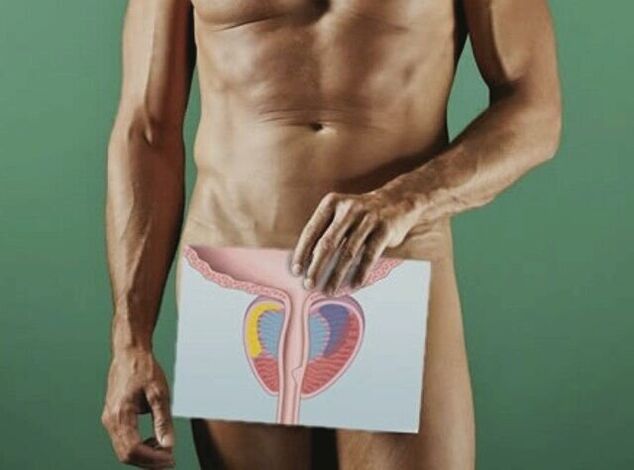
The term "prostatitis (microbial code 10 - 41)" refers to inflammatory processes occurring in the tissues of the prostate gland and leading to pain, difficulty urinating, frequent urination, decreased libido. According to various statistics, the disease mainly affects men of reproductive age, ie from twenty-five to fifty years. Depending on the characteristics of the symptom complex and the degree of damage to the gland, two forms of prostatitis are distinguished - acute and chronic.
According to the coding of MCB, chronic prostatitis receives a value of 41. 1, for the acute form the code 41 is used. 0. The primary diagnosis is made by visual examination of the patient and examination of the anamnesis. Additional techniques are used for confirmation: ultrasound and laboratory methods.
General characteristics and classification
Every third member of the strong half of humanity knows what is prostatitis, which occurs in various forms, as this disease, provoked by inflammation of the prostate gland, is one of the most common pathologies of the male genital area. The disease manifests itself with characteristic symptoms: pain, burning sensation, aggravated by the act of urination, decreased sexual activity, frequent desire to go to the toilet.
Prostatitis in men is a consequence of damage to the prostate by infectious agents that penetrate its tissues through the reproductive organs or systemic circulation. Even causes such as the common cold or bronchitis can provoke an inflammatory process. Most often this happens against the background of factors conducive to the spread of infection, among which in the first place is called weakened immunity.
To get averages, there is a statistical coding of prostatitis mkb 10, which allows you to objectively assess the situation in terms of morbidity of the male half of the population. Chronic prostatitis mkb 10 has code 41. 1, which is attributed to a disease that lasts six months or more. In addition, the classification of the international code ICB 10 xp prostatitis characterizes this form of the disease as difficult to treat.
The code of acute prostatitis mkb 10 is slightly different - 41. 0. This form of the disease is recognized as well-tolerated therapy and takes place against the background of severe symptoms of the disease. There is also a code 41. 2. This indicator is usually used to indicate a disease associated with the formation of a prostate abscess. It is important to know that the diagnosis of chronic prostatitis recommends that the man undergo treatment at least once every six months and visit a specialist regularly.
Predisposing factors
The likelihood of acute and chronic prostatitis in men increases significantly against the background of the negative effects of predisposing factors. The following causes can become a kind of catalyst for inflammatory processes affecting the tissues of the prostate gland:
- Stagnation phenomena, characterized by impaired blood flow and occurring against the background of a sedentary lifestyle, low sexual activity, overweight.
- Systematic hypothermia of the body caused, for example, by the peculiarities of the work.
- Injuries, regardless of their nature and time elapsed since the injury.
- Infectious, viral diseases of the genital area, including sexually transmitted diseases.
- Infectious and inflammatory diseases of other systems and organs, such as bronchitis, purulent tonsillitis and many others.
As an additional predisposing factor, practical medicine points out the problems with digestion, expressed in the appearance of systemic constipation. Thus, an inappropriate approach to nutrition can have an indirect effect on the occurrence of inflammation of the prostate gland.
Important! Timely elimination or reduction of the influence of negative factors is the most reasonable and effective method of preventing prostatitis in men.
Clinical picture
Probably many people know what prostatitis of various forms is. But not everyone is aware that the classic signs of this unpleasant disease can change significantly depending on the stage and form of the pathology:
- Catarrhal prostatitis. The disease is characterized by the appearance of pain in the perineum, groin, frequent urges to the toilet.
- Follicular prostatitis. The pain syndrome becomes more intense, there are difficulties in urinating and there may be a false urge to go to the toilet.
- Parenchymal prostatitis. Severe pain syndrome, aggravated by the act of urination or defecation, often there is a delay in the flow of urine, false desire to go to the toilet, fever, chills, weakness, fatigue.
The course of chronic prostatitis is accompanied by the appearance of almost all the signs listed above, but the symptoms become more worn out. It should be emphasized that the acquisition of a chronic form of the disease is quite rare against the background of exacerbations. Mostly this form of the disease develops in men gradually, under the influence of inflammatory processes resulting from infectious damage to the tissues of the prostate gland. Its main symptoms are:

- Dysuric syndrome. Against the background of the negative impact of inflammatory processes, the prostate gland significantly increases its volume, which leads to compression of the ureter. This pathology is the main reason for the appearance of frequent urges to urinate, including false, painful sensations.
- Pain syndrome. The prostate itself is devoid of nerve endings, respectively, the painful sensations of prostatitis are a consequence of the spread of inflammatory processes and damage to nerve fibers adjacent to the prostate gland of the pelvic organs.
- Sexual dysfunction. Diseases of the prostate gland are characterized by the appearance of various sexual disorders. Most men complain of a decrease in the intensity and brightness of the sensations received during intercourse; in the early stages of the disease, a decrease in libido and lack of erection is possible. Advanced impotence is characteristic of advanced forms of pathology.
You should know that the development of prostatitis is often accompanied by disturbances in the psycho-emotional background of the patient. The man becomes more irritable, it is possible to develop depressive states, nervous breakdowns.
Prostatitis is associated with a characteristic clinical picture, which greatly simplifies the timely diagnosis. The main diagnostic methods are rectal examination performed by a specialist by hand, ultrasound examination, as well as collection of urine and prostate secretion for analysis in the laboratory.
Methods of treatment
How to treat prostatitis, which methods will be most appropriate in a particular clinical case, is determined exclusively by the attending physician based on test results, physiological characteristics of the patient, the form and degree of development of the disease. The most commonly used methods of complex therapy, including medication, physiotherapy, folk remedies, and dietary adjustments.
Treatment of chronic form
Chronic prostatitis is a particularly unpleasant disease, its treatment is fraught with a number of problems and difficulties, it is almost impossible to completely eliminate the disease. However, the use of competent therapy will allow to achieve long-term and stable remission, as well as eliminate the main symptoms of the disease and significantly improve the quality of life. The main methods of treatment are:
- Medical treatment. The choice of drugs is made according to an individually developed scheme by a specialist, using mainly antibacterial and anti-inflammatory drugs. To eliminate the pain in the early stages of treatment, it is permissible to use painkillers.
- Physiotherapy. To stimulate the regenerative processes and increase the effectiveness of the active components of the drugs, along with drugs, physiotherapeutic methods are used, such as laser therapy, magnetic therapy, electrophoresis.
- Massage. One of the most effective methods of treating prostatitis, regardless of its form and stage, is prostate massage. The procedure helps to relieve inflammation, eliminate the phenomena of stagnation, pain. The massage is usually performed by a specialist in a medical institution, but if you have to master medical techniques, it is permissible to perform it yourself at home.
- Immunomodulatory therapy. Treatment of chronic prostatitis includes mandatory intake of immunomodulatory drugs that increase immune strength and overall body tone. To eliminate this unpleasant disease, the choice of drugs should be based on the prescriptions of the attending physician.
In addition, treatment involves mandatory withdrawal of the patient from existing bad habits, adjustment of diet and daily routine. The inclusion of a number of products enriched with vitamins and useful trace elements in the usual menu will help strengthen the body. Moderate physical activity is also an important measure. Physical activity will help to avoid stagnation and normalize blood and lymph flow.
Important! Treatment of prostatitis can be carried out only under the supervision of a specialist. Self-administration of drugs or the use of other techniques can lead to negative consequences and worsening of the patient's condition.
Treatment during exacerbation
Competent treatment of acute prostatitis, provided the timely use of adequate therapy, allows you to completely get rid of the disease and normalize the functioning of the prostate gland. It is important to know that this form of the disease tends to become chronic and therefore treatment should be carried out at the onset of primary symptoms.
Treatment of acute prostatitis involves the use of drugs with antibacterial and anti-inflammatory properties. In addition, physiotherapy methods, massage, gentle diet can be used. If the disease occurs against the background of the formation of purulent abscesses, it is necessary to use surgical intervention aimed at opening the capsule, removing purulent masses and eliminating the source of inflammation.
Possible complications
Lack of treatment for both acute and chronic forms of prostatitis can lead to complications. Against the background of inflammatory processes in the form of exacerbations there is a risk of formation of purulent abscesses in the tissues of the prostate gland, ie a type of capsule filled with purulent contents. The patient's condition in such a situation deteriorates sharply, there is a delay in urine flow, intense pain syndrome, fever, chills.
The most common complications of chronic prostatitis include the risk of developing inflammatory processes that affect the tissues of the bladder and genitals. In addition, in the majority of cases the disease is accompanied by sexual dysfunction, leads to decreased libido, various disorders of the reproductive system, and in the most severe cases - to impotence. It is almost impossible to completely cure such pathologies.
It is important to take the necessary measures in a timely manner to cure the disease, prevent complications and acquire chronic or advanced prostatitis. It is necessary to consult a specialist to identify the causes of discomfort and prescribe adequate therapy when the first symptoms of the disease appear. It is the ignorance of the first alarm bells and the lack of the necessary time that leads to serious complications of the disease.






























